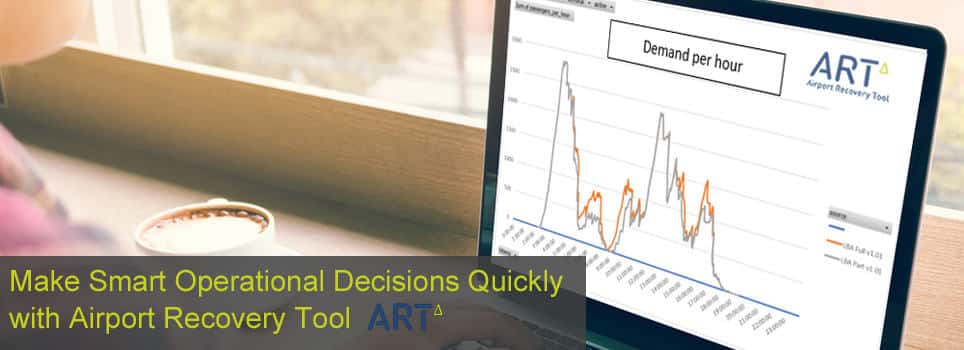
Airport Recovery Tool – ART
AiQ has built its’ consultancy expertise in Demand Forecasting and Capacity Planning over the past 15 years – working with constrained airports such as London Heathrow and Schiphol to fast expanding airports such as Bristol and Budapest. But as we start to see signs of recovery from the pandemic and travel opens up again, what is going wrong as our airports struggle to handle traffic volumes which are still well below their pre-March 2020 levels? (The ACI reported 66% in March 2022.) Why are airports around Europe struggling to recover full-service levels?
In our last blog we highlighted three issues that needed to be prioritised:
- Staff shortages with recruitment struggling to catch up
- Uncertainty over COVID-19 travel regulations
- Automation only partially implemented
But what mitigations are possible?
The above three issues affecting airports throughout Europe will be resolved over time. But what can airports do between now and the next peak in activity in Summer 2022?
Capacity Planning
Pre-COVID an annual airport capacity plan based on a thorough activity data collection survey would have been developed around the flight schedule. In AiQ we would have taken stock of passengers, baggage, GSE, transit vehicles and ancillary activities such as trollies, PRM’s etc. It may have received minor updates, but the experience of the airport planners would have made those corrections.
As of now, going into Summer 2022, the situation is so volatile that activity data collection surveys are being carried out weekly, or even on a continuous basis in some airports, to try to understand the resources needed to operate.
What to measure?
The schedules will stabilise, but load factors are very variable in between the peaks of heavy traffic.
The ‘peak hour’ has returned but the flows around ‘peak hour’ can be very different regardless of the flight schedule. The demand may only be 60% of total pre-COVID volumes but the peak flow has come back sooner and the behaviour characteristics of different passengers on different airlines to different destinations need to be factored in. A queue does not take long to form as many of our simulations show.
Rapidly changing schedules due to cancellations and changing load factors due to the ‘lumpiness’ caused by peak hour is making it difficult to resource shifts. The peak hour will often be spread over two shifts leaving quiet periods in between. Quiet periods don’t make money!
What analytics tools to use?
Pre-COVID an airport may have used an established licensed software such as CAST® or Beontra® and Transoft®. In AiQ we developed our own internal tool TransvisionAir in order to integrate passengers, baggage, GSE and Aircraft.
In our blog of Nov 2018 called ‘How can you find capacity in constrained and saturated airports?’ we talk about capacity planning in ‘constrained airports’ operating in excess of 95%.
In that blog we state:
AiQ use historical Big Data profiling with Monte Carlo assessments of future Schedules & Occupancies to find and explore trends. We also know about the impact of new automated technology and processes on passenger behaviours. It’s important to understand and develop the airport around the different airline operating models. We specialise in realising this capacity by thinking the process through and being smarter.
CAST® and Beontra®, like TransvisionAir, are also based on complex assumptions however at the current time, Summer 2022, the tools to carry out the data analytics need to be simple, quick and cheap to use.
Airport Recovery Tool – ART – A practical way to help
ART was conceived as a simple and powerful tool relying upon extensive experience of operational behaviour built into the software. It models from the flight schedule and produces output on 18 processors – passengers, baggage, cargo, GSE, aircraft etc.
It provides a simplified modelling approach which gives quick resource analysis making it ideal for the period ahead.
Combined with managements’ own knowledge and experience it facilitates better quality decisions. More importantly it allows management in different functional areas to share their data and assumptions made ensuring joined up thinking. This is reported in a single set of reports not numerous spreadsheets. The 18 processors analysed provide a holistic view of the resources and equipment needed in any time period from kerbside to runway.
Operational planning has never been an easy task for the airport but responding to the changing needs of the airlines has become more complex than ever. All parties are aware of the challenge. ART is a tried and tested tool to alleviate the challenges.
ART is available as a license or as a service utilising AiQs’ holistic airport planning expertise. It holds our experience and knowledge as a backroom tool to help tackle the airport capacity planning challenge head on. It is also surprisingly cost effective.
If you are experiencing operational planning challenges, then you need to give us a call.
At AiQ, our award winning team of operational and analytical experts are dedicated to analysing, modelling and optimising every aspect of an airport. Specialising in airport capacity, we are trusted to realise capacity and solve complex operational challenges. Read some of our testimonials.
For more information about how we can assist your airport capacity challenges in 2022, contact us today.

